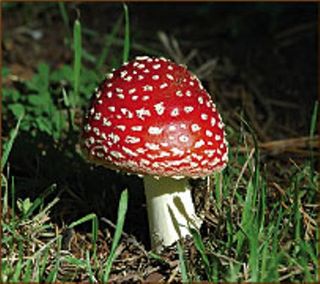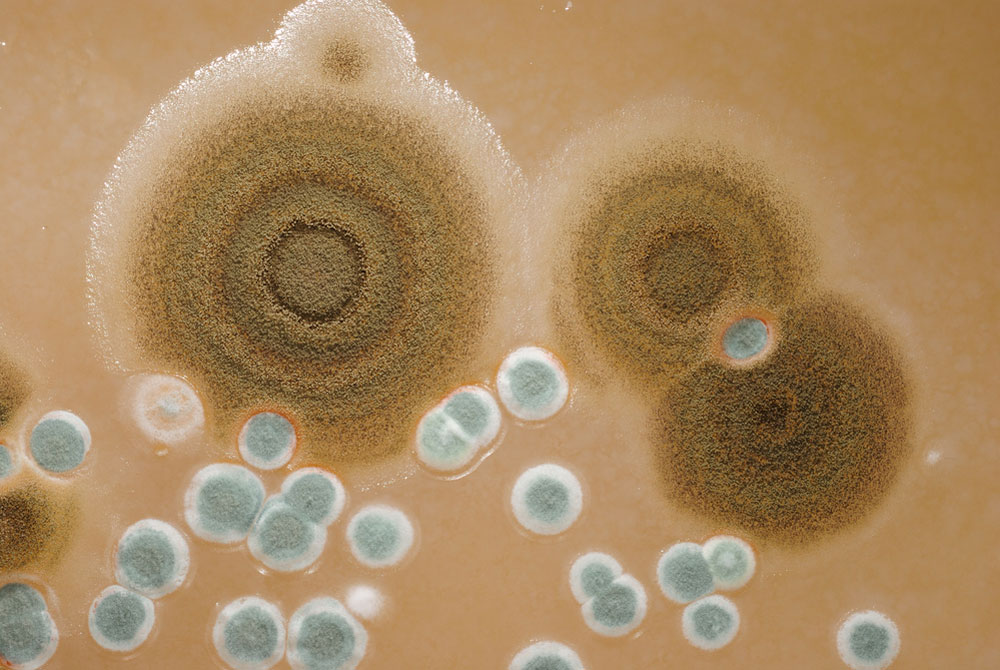Do Fungi Make Their Own Food
Facts About the Fungus Among Us

Tens of thousands of organisms, from mushrooms to mold to yeast, autumn under the umbrella of fungi. Once idea simply to be plants, fungi have emerged as their own taxonomic kingdom. The diverse fungal species are diverse, with many unique backdrop: some innocuous, some useful and some harmful.
Classifying fungi
It has taken decades, every bit engineering improved and scientific cognition evolved, to appropriately classify this myriad group of organisms.
As recently equally the 1960s, fungi were considered plants. In fact, at that fourth dimension all organisms were classified into only two groups or kingdoms: plants and animals. In a 1969 article published in the journal Scientific discipline, ecologist Robert Whittaker explained the ground of this ii-kingdom organization. For many decades in history, the but living creatures humans observed around them were either the "rooted" plants that produced their own food, or motile animals that sought out their food. Thus mobility and the method of gaining nourishment became the criteria for a system of classification. "The animals moved and plants didn't, and that's how fungi got stuck with the plants," said Tom Volk, a professor of botany at the Academy of Wisconsin-La Crosse.
However, unlike plants, fungi do not contain the dark-green pigment chlorophyll and therefore are incapable of photosynthesis. That is, they cannot generate their own food — carbohydrates — past using free energy from calorie-free. This makes them more like animals in terms of their food habits. Fungi need to absorb nutrition from organic substances: compounds that contain carbon, like carbohydrates, fats, or proteins.
Based on these and other backdrop, in 1969 Whittaker proposed that fungi go a divide kingdom every bit a part of a new five-kingdom system of nomenclature. The proposed classification included a vast array of species. Amid them, mushrooms, yeast, molds, slime molds, h2o molds, puffballs and mildews.
Since then, the organization of nomenclature and the fungal kingdom have been further refined. For case, slime molds and water molds were shuttled off to a dissimilar kingdom. Today, the members of the kingdom Fungi are also known every bit the "truthful fungi."

Characteristics of 'truthful fungi'
Co-ordinate to "Van Nostrand'south Scientific Encyclopedia, Vol 1, 10th Ed." (Wiley, 2008), the numerous fungal species accept "widely diverse habits and characteristics," and generalizations can be difficult. Nevertheless, there are a few key aspects common to all members of the fungal kingdom.
Cells: Fungi are eukaryotes, merely like plants and animals. This means they have a well-organized cell, characteristic of all eukaryotes. Their DNA is encapsulated in a central construction chosen the nucleus (some cells can have multiple nuclei, according to "Van Nostrand"). They likewise have specialized cellular machinery chosen organellesthat execute diverse dedicated functions such as energy production and protein send.
Fungal cells are encased in two layers: an inner cell membrane and an outer jail cell wall. These two layers accept more in mutual with animals than plants.
Like animal cell membranes, those of fungi are made of proteins and fatty molecules chosen lipids. In addition, animal cell membranes contain varying amounts of cholesterol. Similarly fungal membranes contain a unique steroid called ergosterol, according to Volk.
Establish prison cell walls are made of cellulose, whereas fungal cell walls take chitin, a distinctly non-plant substance. In fact, the exoskeletons, or the outer hard crush of various arthropods (insects, and crustaceans like crabs and lobsters) are made of chitin.
Structure: Fungi can be made up of a single jail cell every bit in the example of yeasts, or multiple cells, as in the case of mushrooms.
The bodies of multicellular fungi are made of cells that band together in rows that resemble the branches of trees. Each individual branched construction is called a hypha (plural: hyphae). Most oft, the individual cells in hyphae sit down correct next to each other in a continuous line (also known as coenocytic hyphae) just they can sometimes be separated into compartments by a cross wall (septate hyphae). Several hyphae mesh together to form the mycelium, which constitutes the fungal body, according to "Van Nostrand."
"The fungi are the kings of surface surface area," Volk told LiveScience, explaining that hyphae expand their surface expanse in social club to take in food, facilitate digestion and also to reproduce.
Nutrition: As mentioned earlier, since fungi cannot bear photosynthesis, they demand to absorb nutrients from various organic substances around them. This makes them heterotrophs, which literally translates to "other feeding," co-ordinate to Volk.
Animals are heterotrophs as well, and need to seek out their food. Merely in their example, digestion takes place inside the body. "Fungi are unlike," Volk told LiveScience. "They find their food, they dump their enzymes out on to the food, and digestion takes identify outside their trunk." These specialized digestive enzymes are known as exoenzymes, and are secreted from the tips of growing hyphae onto their surroundings, Volk states in the "Encyclopedia of Biodiversity, second Ed." (Academic Press, 2013). These enzymes are the primary reason why fungi are able to thrive in diverse environments from woody surfaces to insides of our body.
As a result of exoenzyme activity, large nutrient molecules are cleaved down into smaller ones, which are brought into the hyphae. Cellular respiration so takes place within fungal cells. That is to say, organic molecules such as carbohydrates and fat acids are broken downwardly to generate free energy in the form of ATP.
Fungi have multiple sources of food. Fungi that feed on dead organisms — and help in decomposition — are called saprophytes. If a fungus derives sustenance from a alive host without harming it, then it is called a symbiont or a mutualist. Lichens — fungi and algae together — are an instance of a mutualistic human relationship. If a fungus feeds on a live host while harming it, then information technology is a parasite, according to the "Encyclopedia of Biodiversity."
Reproduction: The various fungi are capable of reproducing asexually or sexually. Both processes tin generate spores. These are special cells, which when released into a suitable environment, can give ascension to a new fungal torso. Spores can be carried to new environments past air or water, co-ordinate to Utah State University.
Asexual reproduction occurs through mitosis, when a fungal prison cell divides and produces identical genetic copies of itself. In simpler, single-celled fungi similar yeast, this process is known every bit budding. In this case, a small offshoot or bud emerges from the parent cell, slowly growing in size. The nucleus divides into two and the bud splits off once it is the aforementioned size equally the parent prison cell. On the other mitt, multicellular fungi such equally molds reproduce through the formation of asexual spores.
The duration and timing of sure steps of sexual reproduction vary quite a bit betwixt fungal species. Moreover, the reproductive structures as well vary from species to species. And then much and so, that these morphological differences grade the basis for dividing the fungal kingdom into sub-groups or phyla, according to the "Encyclopedia of Biodiversity."
Sexual reproduction in fungi produces spores through meiosis. As a issue, these spores contain half the number of parental chromosomes. Once released, the spores germinate into tree-similar mycelia and are prepare to "mate." In the instance of mushrooms, puffballs and toadstools, the branched mycelium (also called master mycelium) is divided into segments containing a unmarried nucleus. Mating takes identify when two primary mycelia come into contact with one another and class a secondary mycelium. Each segment of the secondary mycelium has two nuclei: i from each original segment. The private nuclei all the same have one-half the number of chromosomes equally the parent cell. In the class of several steps nuclei fuse, giving rise to cells with the original number of chromosomes. Subsequently this point, the sexual reproductive cycle begins over again: meiosis occurs and spores are produced, according to "Van Nostrand."

Fungus and us
Fungi are inextricably linked to our lives and livelihoods. They affect our health, food, industry and agriculture in both positive and vexing ways.
Fungi are sources of important medication. The antibiotics penicillin and cephalosporin, besides equally the drug cyclosporine, which helps to forestall transplant rejection, are all produced by fungi, co-ordinate to the "Encyclopedia of Biodiversity." Withal by the same token, fungi produce toxins chosen mycotoxins that are harmful to united states of america. "Most all mycotoxins are produced past molds," Volk said. For example, Aspergillus fungi that grow on corn and peanuts produce aflatoxins. This mycotoxin is considered a carcinogen and has been linked to liver cancer.
Yeast (Saccharomyces cerevisiae) is essential to the fermentation of wine and beer, and to the blistering of raised, fluffy staff of life. The feature azure hue of bluish cheeses is due to the sporulation of the mucus Penicillium roquefortii, co-ordinate to the "Encyclopedia of Biodiversity." Mushrooms such as chanterelles and morels are tasty additions to meals. Still smut and rust fungi (named for the coaly and rust like appearance of their spores) routinely destroy food crops and plants like beans, barley and pino trees, co-ordinate to "Van Nostrand."
Important scientific discoveries have been fabricated using fungi as model organisms. The discovery that genes control the expression of enzymes, and that one factor controls one enzyme, was a result of experiments with the pink mold Neurospora. Scientists George Beadle and Edward Tatum won the Nobel Prize in 1958 for this work. Yeast has also been used as a model organism for answering questions in the field of genetics. According to a 1997 commodity published in the journal Science, many yeast and mammalian genes code for similar proteins, making it a useful tool for agreement the human genome and disease atmospheric condition such equally Werner'due south syndrome.
Still, what we know about fungi today, and what we can practise with fungi, is just the very first of all that is possible. As Volk states in "Encyclopedia of Biodiversity," there are 75,000 fungal species that are named. But this number is believed to correspond simply 5 percent of the species that exist in nature. "There'southward relatively trivial known about the fungi compared to the animals and plants," Volk told LiveScience. "There's still a lot of new species out there to be discovered."
Additional resources
- Encyclopedia Britannica: Fungus
- Tom Volk's Fungi (University of Wisconsin-La Crosse): Extensive database of fungi and interesting stories
- Genetics: Sporulation in the Budding YeastSaccharomyces cerevisiae
Source: https://www.livescience.com/53618-fungus.html
Posted by: farrquir1968.blogspot.com


0 Response to "Do Fungi Make Their Own Food"
Post a Comment